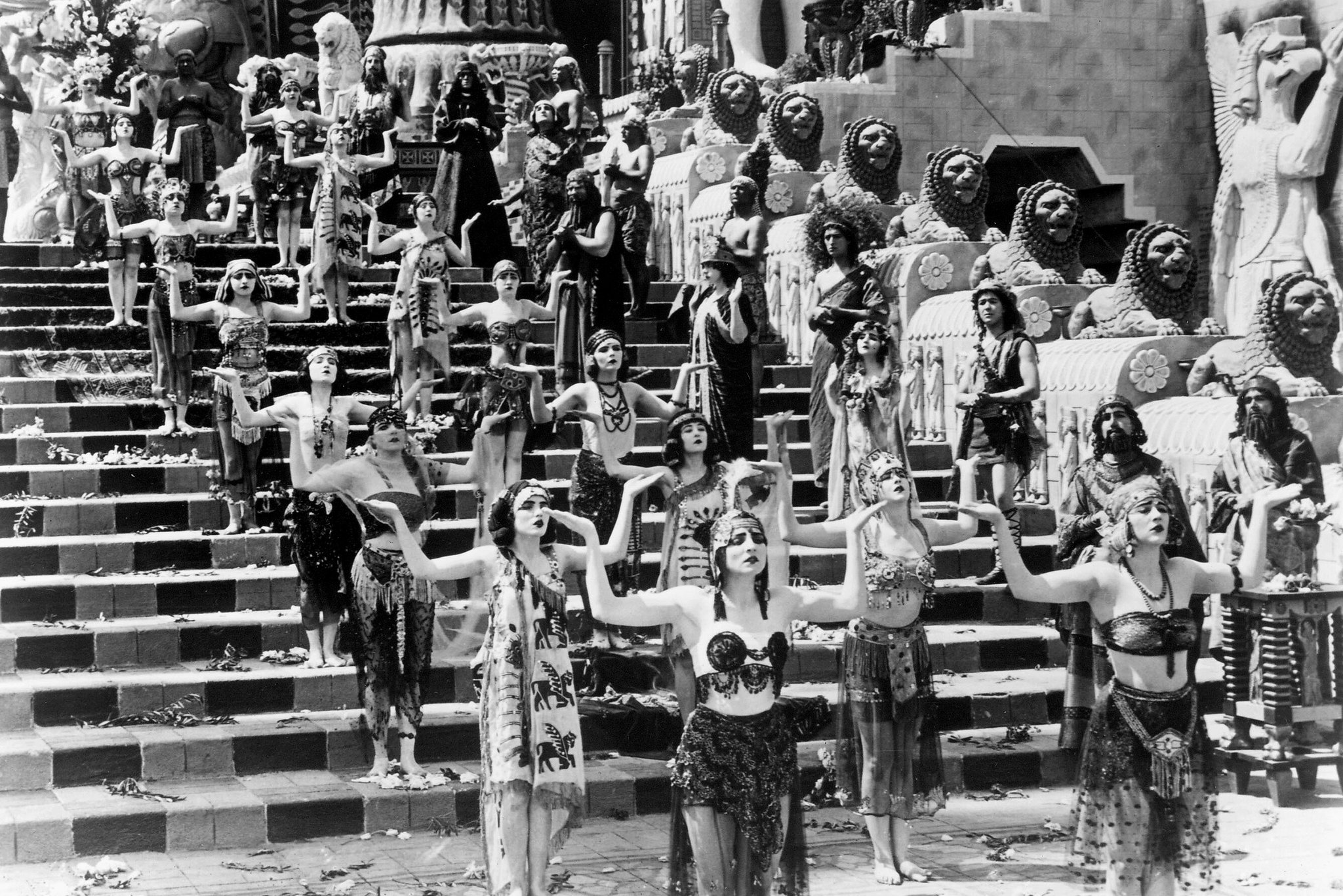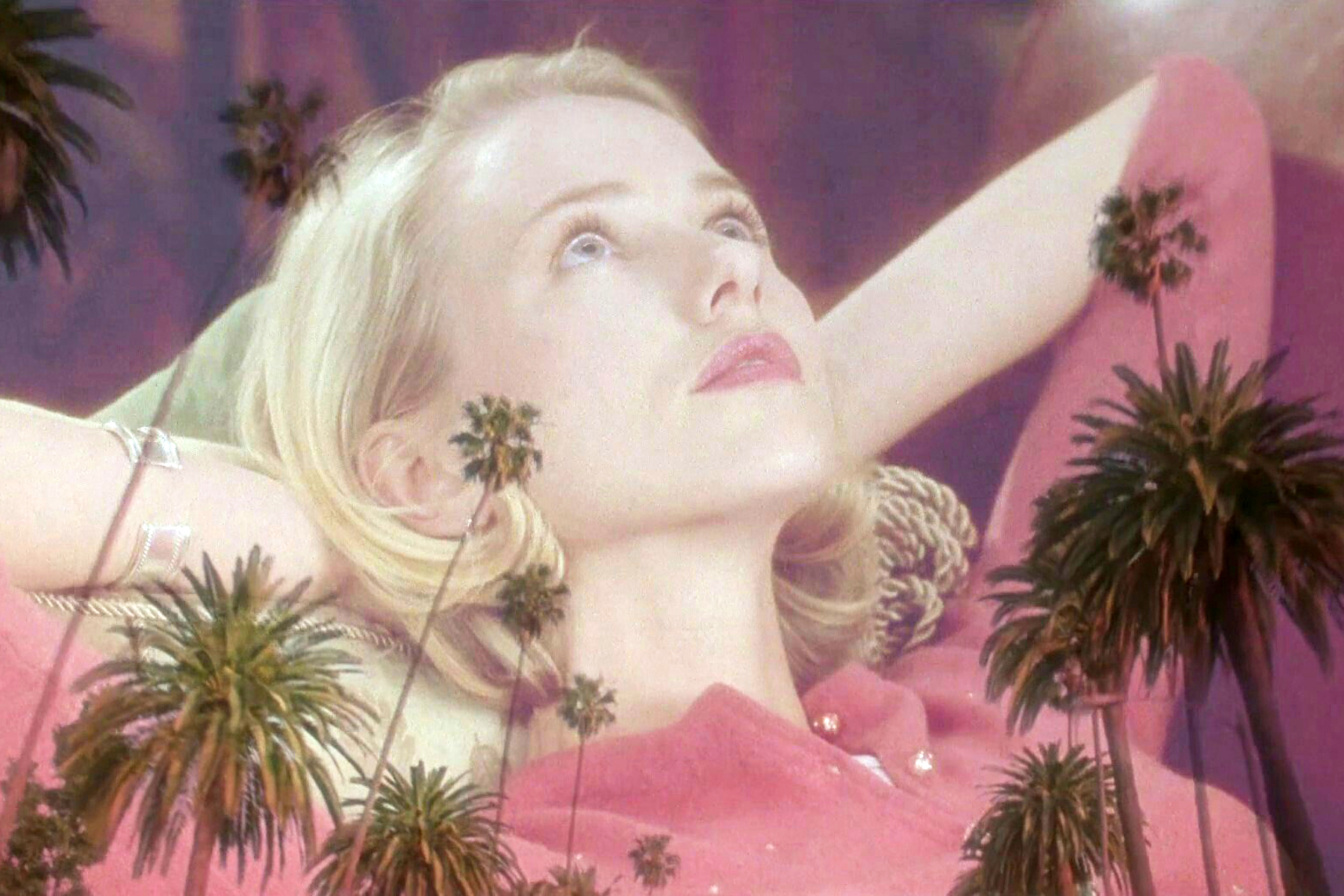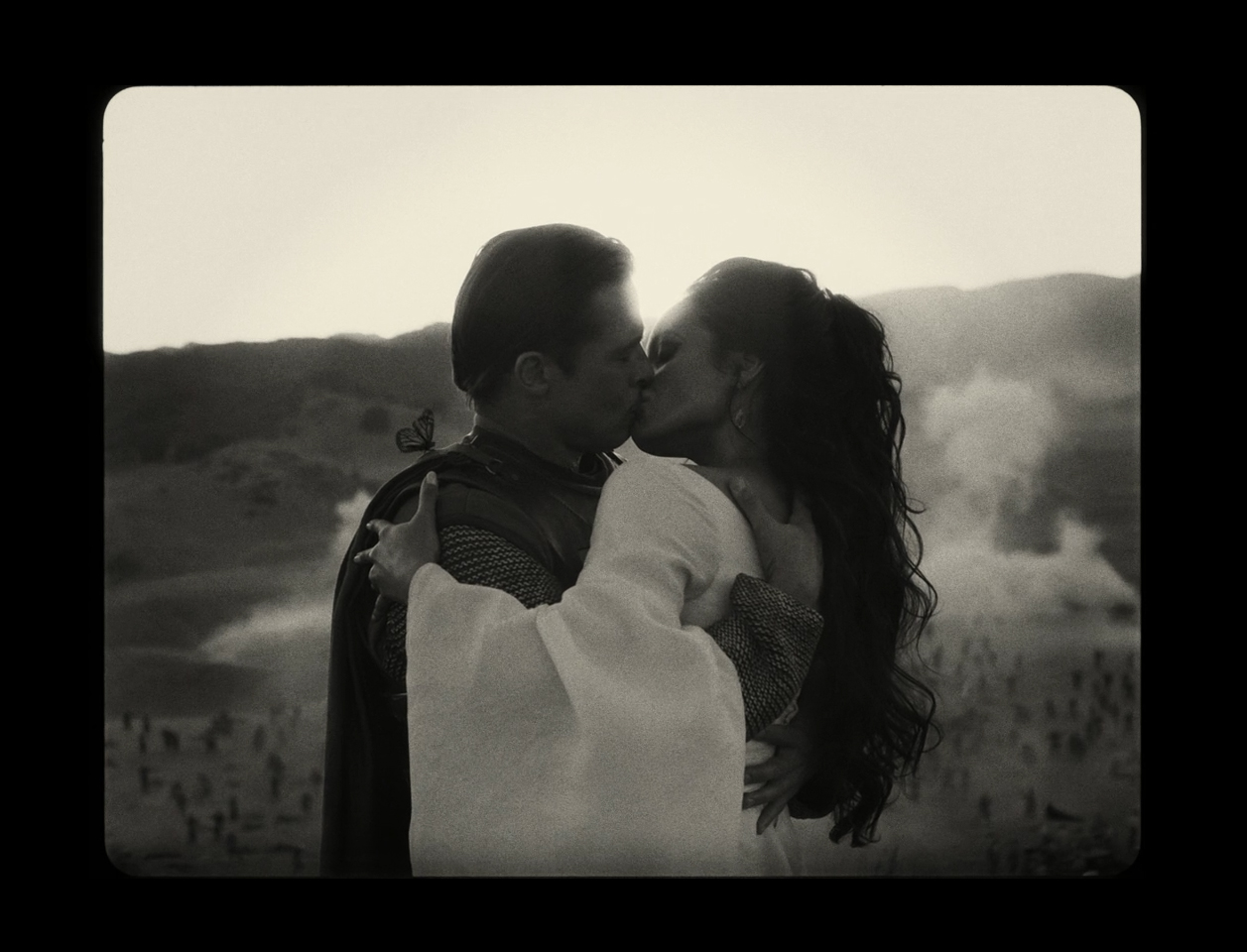Panorama | Hell as other parties. Babylon
-
wherein an elephant crosses through a room (and remains there)
“WHITE ELEPHANTS – the God of Hollywood wanted white elephants, and white elephants he got — eight of ’em, plaster mammoths perched on mega-mushroom pedestals, lording it over the colossal court of Belshazzar, the pasteboard Babylon built beside the dusty tin-lizzie trail called Sunset Boulevard. “ (Kenneth Anger, Hollywood Babylon, 1959).

Hollywood Babylon, Kenneth Anger’s collection of erotic and scandalous history, starts with a white elephant as an emblem of megalomania – D. W. Griffith’s pantagruelian sets for Intolerance, which remained standing as relics long after the principal shooting was over, are a testament of the excess and artificial saturation that are operative for Hollywood. Cut to: Damien Chazelle’s Babylon, where the elephant is a massive beast that is literally being pushed up the hill, in Sisyphean fashion, by two runners who have to also bear its feces, up to the home of a tycoon who is up to his usual hijinks. The elephant is the shtick, the sensation of the party; whenever we witness some fantastic, Persian-like orgy (incidentally, the guests are wearing gold and translucent fabrics), there must be some tiger, lion, or some other animal around that scares the drunken masses out of their wits, waking them up lest they end up eaten, or whatever.
Chazelle’s new film contains absolutely no trace of any savant, innovative ideas about Hollywood (according to all parameters, Chazelle creates a pastiche of all and any films that disparage, taint or dishonor the Hollywood film industry), rather being much more of a fictional collection of gestures, stories or tapestries of characters that truly existed within the industry, albeit maybe not that outrageous. These characters are typical for the prodigious narration that are part of Hollywood’s myth-making: the girl that dreams to become a star (Nelly la Roy, performed by Margot Robbie, akin to an inextinguishable fire across the entire film), the neophyte who dreams to become a hot-shot on set (performed by Diego Calva, fresh and authentic) and a mammoth-actor that experiences a decline once sound cinema comes around (Jack Conrad, performed by Brad Pitt, inspired by John Gilbert).

Chazelle’s sources are sometimes obvious (and mostly culled from Anger’s book) – he suavely recreates the memorable scene in Josef von Sternberg’s Morocco (1930) that features Dietrich’s dance number, dressed in masculine clothes, ending it by kissing a girl in the audience; he recreates entire sequences from Gene Kelly’s Singin’ in the Rain (1952), finds twins in Sunset Boulevard and Hail, Caesar!, the Coen Brothers’ 2016 comedy – and so on, and so forth. Even so, with all necessary precautions, with all of my reserves, the film remains perfectly valid, sealed off from the rest of the world, like a standalone product floating around in its own fluids and dust for the better part of three hours, embalmed within its naive and rotten anachronism, wrapped in a scarlet tone that seems to make everything seem even more cooked than it should be, only for it to end up gratifying itself with a collage of films that communicate with each other across time, tracing and imaginary, impossible history.
I will end this heavy accolade, written down in a heartbeat, defending a film that redefines the way in which we may still regard the films of today; it’s a meta-cinematic offering that is aware that it’s fake to the degree to which it bears the weight of all its predecessor’s work – it’s an artificial construction whose sole foundation is cinema itself.
-
four déjà-vus –
“The road to glory was beset with booby traps.” – Kenneth Anger
It’s true that there have always been stories about “Big Bad Hollywood” running around (starting with Raymond Chandler’s literary satires, F. Scott Fitzgerald, Aldous Huxley, etc.). And it’s true that Hollywood has gained this big bad world reputation, the one that promises European directors that they’ve struck gold while forcing upon them the same residual storylines, told from slightly different angles. And it’s true that there are still films being made today that entertain the dream of Hollywood, or that they don’t completely discard it – one of them is made by Chazelle himself, La La Land, which is much more about the magic of cinema than it is about the horrors hidden beneath it (even though Mia’s character is desperate to get on the top, but she has little to no chance to pass an audition), and maybe it’s because its perfectly anchored in an artificial, eye-candy-like aesthetic. Even so, most films veer towards demolishing the totemic images that have become habitual in relation to Hollywood (the four déjà-vus, as I will call them).
First, the passing of palm trees – Neon Demon, Refn’s cannibalistic horror, turns nocturnal tracking shots of Los Angeles boulevards, once bubbly and luminous, into veritable demonic caverns.
Second, the interminable line of people waiting in front of the gates of the production studios, fans who wait for days on end for the chance to work as an extra – whereas Ryan Murphy’s Hollywood sustains this typical image, for Chazelle, it’s laughable. In Babylon, the so-called gate is a dusty dump in the middle of the desert, half derelict, a half poster of a bar; inside, we see a collection of postcards from other lives, one which cinema only can render like this – from a pile of hay, of dirt or dust, in the middle of the desert, there appears the magic of silent cinema.

Third (and most famously), the close-up of the aspiring star, usually a woman, usually a provincial that is enveloped by the Hollywood dream that she will, later on, get to experience herself – she’s plastered on the pages of tabloids, she appears on the covers of prodigious magazines, she’s the sensation of the moment. This image is best deconstructed in David Lynch’s Mulholland Drive, when the same sinister palm trees are superimposed onto Naomi Watts’ figure, a harbinger of misfortune vs. Babylon, where Nelly sees herself on the big screen for the first time – and even though she’s playing the most depraved role one can imagine, she’s crying tears of happiness.
Just like Greg Jericho shows in Hollywood Dreaming: Satires of Hollywood 1930-2003, Hollywood is the place where the artificial is superior to the real (in Babylon, the glycerine that produces tears is wasted by a dummy who thinks that it’s a lubricant), and the Hollywood dream, which ends up substituting the American dream, is nothing more than simulacrum – it’s disconnected from reality, it’s an artificial construct, it’s on life support, and it only works within its own boundaries/sets. This is where the fourth image derives from: the romantic walk through false sets (especially those used on westerns) – for example, the one from Sunset Boulevard when the young scriptwriter tell the young pretender that she spent her entire childhood playing there.
In Babylon, Hollywood is not necessarily an evil entity, but rather, it’s cynical and circumstantial. Chazelle compiles the plot of Sunset Boulevard (Norma Desmond, a former star of silent cinema, experiences a narcissistic fever dream amongst the walls of a baroque Xanadu; outside these walls, she is simply just yesterday’s news), and Gene Kelly’s Singin’ in the Rain, which captures the transition to sound cinema. Just as bitter-sweet my favorite scene from Sunset Blvd is when Desmond finally gets to see Cecille DeMille in order to admonish him, after years of being trapped, only for a microphone to flatten the top of her flamboyant hat, here we have the character arcs of Nelly la Roy and Jack Conrad (Robbie and Pitt), who have no way of keeping up with the talkies. The first one is disadvantaged by her New Jersey accent, which shatters glass (in the spirit of Lina from Singin’ in the Rain, who ends up being dubber or, more hilariously, in the same vein as the cowboy in Hail, Caesar!, is sent off to make romantic comedies), while the second, not at all talentless, cannot be afforded by the industry anymore.
-
a butterfly lands on his shoulder
What is the purpose of all of this? This is what I was wondering at the end of the nauseating saturnalias that constitute the beginning of Chazelle’s film – the elephant whose jungle roar throws the naked, erstwhile glorious and fearless partygoers to the ground, rendered tiny and suffocated by their own shame. It’s the morning, and a few of them are asleep in their own vomit, but it’s the dawn of a new day, the sun is rising onto the horizon and Nelly has just landed a role in a film that she knows nothing about, just because someone overdosed after playing a game of cocains and golden showers. From here, the tone of the next sequence will be the object ofthe entire interplay in perspectives and accumulations that Chazelle uses to construct his thesis, one can only be formulated in a reductive way, along the lines of “look how a butterfly lands on the shoulder of Jack Condrad, who is extremely drunk, climbing up a hill wrapped in the fading, scarlet-pink light of the vening, and just as the director screams ‘Action!’, the drunkard simply transforms, as if suddenly awake, and as kisses his chimera-like lover, the sun sets between their faces, oh, the movies are simply wonderful”.

Babylon sits at this improbable intersection between muck and miracle: less than a mile away from the butterfly scene, a fire burns a set into the ground, and less then a foot away, one witnesses the epiphany of Nelly, who can cry on command, rendering the producers and assistets speechless. This amalgamation of simultaneous events, regarded in parallel, alongst the principle of the Butterfly Effect, along with the excess in vulgar accumulation (be it excessively sexualized characters, or an excess of cocaine – or joy powder, as K. Anger playfully calls it), leads not to putrefaction or distruction, but rather, before it fully runs out, generates a sort of epiphenomenon, like Nelly’s exit from the frame, disappearing into the darkness of the night. Even Conrad’s discreet suicide, although impactful, has something of this air of epiphany. From this point of view, this grotesque-miraculous dichotomy in Chazelle’s film no longer seems far-fetched or too strident, it’s just unusual – it reconciles both the director’s visible love for cinema and the impossibility of loving an industry that is as pagan as the one in Hollywood. In the end, I find it truly touching, this transition from moving images to pigments dissolving by celluloid in water, as if they like fish, floating amongst each other, like a final memento of Bazin’s theory of the mummy.
Journalist and film critic, with a master's degree in film critics. Collaborates with Scena9, Acoperișul de Sticlă, FILM and FILM Menu magazines. For Films in Frame, she brings the monthly top of films and writes the monthly editorial Panorama, published on a Thursday. In her spare time, she retires in the woods where she pictures other possible lives and flying foxes.
